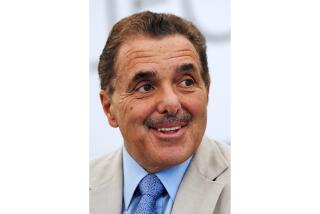Wolfe’s Latest Takes the Long Route to Bookstores
Tom Wolfe spent so much time writing his new novel that he picked and later discarded two titles (“Chocolate City” and “The Stoics’ Game”), and was able to cut a big section and publish it as a stand-alone tale in Rolling Stone two years ago. “Ambush at Fort Bragg,” as this excised portion was called, went on to become a best-selling audio book, narrated by actor Edward Norton.
And now, finally, the book is here.
Eleven years after Wolfe’s “The Bonfire of the Vanities” helped define the greed-is-good decade with a rollicking story, “A Man in Full” is expected in stores Nov. 9 or 10. (The official publication date is Nov. 12.)
“Bonfire” was introduced by Farrar, Straus & Giroux with a memorable, 600,000-copy first printing. It went on to sell about 750,000 in hardcover, and there are nearly 4 million copies of the Bantam paperback in print.
Farrar, Straus will release “A Man in Full” with a first printing of 1.2 million. Two encouraging signs for the publisher: Judges, who had been given prepublication copies of the novel, recently placed it among the fiction finalists for this year’s National Book Awards (to be announced Nov. 18), and, earlier this week, the book already ranked as the 15th-biggest seller at the online bookstore Amazon.com, which has been taking prerelease orders.
An excerpt has run in Men’s Journal, and Time features Wolfe on its cover this week--ever dapper in an ice-cream-white suit and stylish fedora, walking stick at the ready.
Time reviewer Paul Gray extends a rave in his profile of the author: “Those expecting another ‘Bonfire’ may be disappointed--the new novel is better. It’s not quite as glitzy and brash and hilariously in-your-face as its predecessor, but then Atlanta in the late ‘90s, where most of the action occurs, is a more well-mannered place than New York City was in the ‘80s.”
Gray needs a few hundred words just to describe Wolfe’s story of real-estate developer Charlie Croker, his financial meltdown and its ripple effect on a $14-an-hour laborer in Oakland. But “at its heart,” Gray concludes “ ‘A Man in Full’ is a cliffhanging morality tale.”
A fellow named Paul McHugh, whose “unfailing kindness saved the day,” shares in the book’s dedication. In Time, it is explained that McHugh is a psychiatrist at Johns Hopkins Hospital in Baltimore who helped his friend Tom climb out of a depression that crippled him early last year, months after he suffered a heart attack and underwent quintuple bypass surgery.
“I’d never been depressed before,” Wolfe tells the magazine. “I looked at the novel and thought it was a failure.” Another reason for the long wait.
Roger Straus, the colorful and salty-tongued president of Farrar, Straus, looked back at the years that have passed since “Bonfire” and laughed: “I’ve aged,” he told Newsday. He is 81 now. But no one is more effusive about the books he publishes.
“I think it’s bigger than ‘Bonfire,’ ” Straus said of Wolfe’s latest. “The reaction has been great. Even the foreign publishers at the Frankfurt Book Fair who had a chance to read it were crazy about it.”
Wolfe will be profiled by CBS’ “60 Minutes” (tentatively scheduled for Nov. 8), and is expected to visit “Today,” “Good Morning America,” “The Late Show With David Letterman” and “The Charlie Rose Show” during the week of publication.
Wolfe’s publisher has set up a Web site for the new book and has posted excerpts at https://www.tomwolfe.com.
A publishing event indeed.
Ali and the New Yorker: They were setting up police barricades around City Hall in New York on Oct. 22 to contain the crowds expected for the Yankees’ victory parade the next day. But a big champion was already at City Hall, the restaurant on nearby Duane Street.
Muhammad Ali showed up for a party celebrating the publication of “King of the World,” in which David Remnick, now the editor of the New Yorker, chronicles the fighter’s rise to worldwide fame and his self-creation during the racially charged 1960s. It was a measure of Ali’s enduring appeal that the most powerful figures in the room were among the first to go over to meet him. They included Random House chairman Peter Olson and Thomas Middlehoff, who today becomes chairman and chief executive of Bertelsmann, the publishing company’s parent corporation.
Among the other guests were Philip Roth, Joan Didion, John Gregory Dunne, Dick Schaap, and New Yorker writers Joe Klein, Kurt Andersen and Jeffrey Toobin.
“King of the World,” subtitled “The Rise of Muhammad Ali,” is one of Random House’s big nonfiction titles for the fall. Writing in this week’s Time, Wilfrid Sheed calls the book “haunting.” It’s Remnick’s third since “Lenin’s Tomb” earned him a Pulitzer Prize in 1994. Busy man.
Also attending the party, and having his own reason to celebrate, was a less familiar face--David Carey, who became publisher of the New Yorker shortly before Remnick succeeded Tina Brown as its editor in early summer. Carey is leading a head-turning effort within the industry that is designed to underscore the loyalty of his magazine’s readers by releasing more information than is required of Audit Bureau of Circulations members.
Carey has put out an expanded statement of circulation, validated by the ABC, that shows a repeat subscription-renewal rate among subscribers for two or more years of 81% and a renewal rate among first-time subscribers of 64.3%. Both figures far exceed industry norms and should help the magazine persuade cost-conscious advertisers that their ads will be read.
Average paid circulation for the first half of this year was 813,434.
Of course, the New Yorker not only has a loyal readership to boast about, it also has an urgent reason to do so. For all the attention generated by the magazine and its celebrated writers, especially in media circles, the weekly continues to lose millions of dollars a year. Its number of ad pages was down slightly during the first nine months of this year compared with the same period in 1997.
Confident that the New Yorker can outshine competing magazines when it comes to subscriber loyalty, Carey is daring the others to release the same information.
“Sales executives always boast to advertisers about the bond that exists between their readers and a magazine,” he said this week. “This provides a chance for media executives to say to these salespeople, ‘There’s a vehicle now so you can prove it.’ ”
Brill’s Content Grows: Brill’s Content, the most talked about new magazine this year, is out with its fourth issue (the cover story is on cybergossip Matt Drudge) and its first hike in the circulation promised to advertisers.
Steven Brill, chairman and editor in chief of this “Independent Voice of the Information Age,” says his next issue will come with a so-called rate base of 225,000 copies, up from a guarantee of 150,000 when the magazine launched in June with a blistering account of early Monica Media.
“Frankly, we’ve been delivering past that number (225,000) for the past couple of issues,” Brill said, adding that subscriptions total around 130,000.
Not bad.
* Paul D. Colford’s e-mail address is paul.colford@newsday.com.
More to Read
Sign up for our Book Club newsletter
Get the latest news, events and more from the Los Angeles Times Book Club, and help us get L.A. reading and talking.
You may occasionally receive promotional content from the Los Angeles Times.







